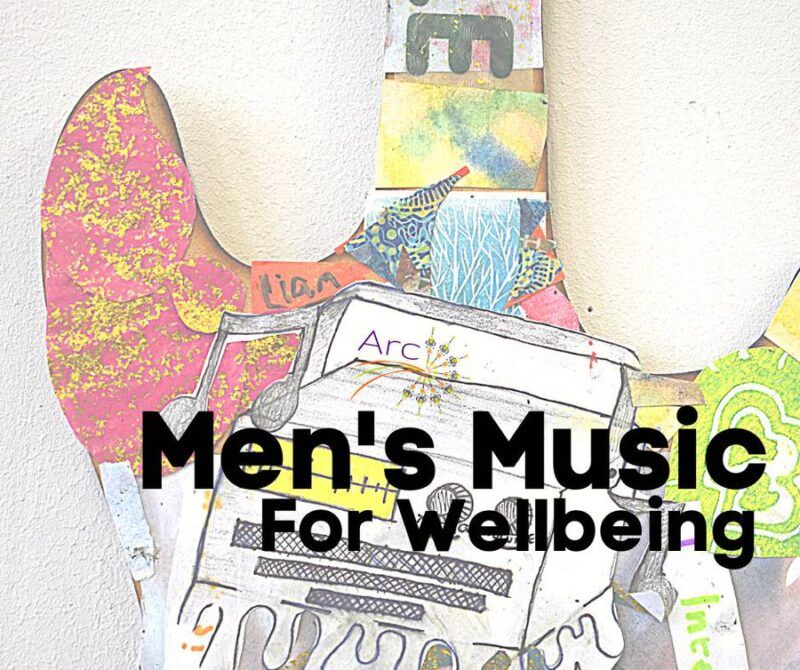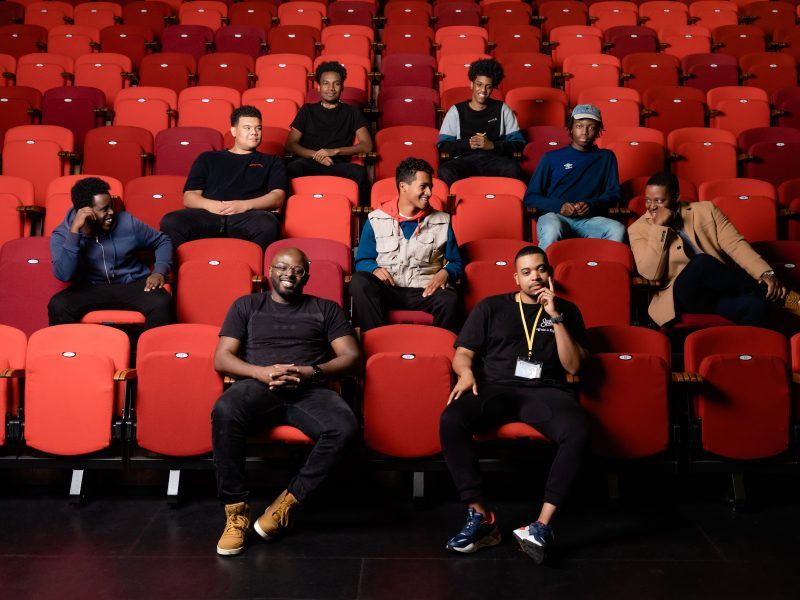November is ‘Movember’, a key month for raising awareness of men’s mental health, so a good time to ask this question.
Taking part in creative activities is now widely understood to have benefits for our mental health and wellbeing. Arts and health, including mental health, is an area of increasing interest, including from the NHS. Our Directory of Arts and Mental Health Organisations (2022) found over 320 arts and cultural organisations across the UK who offer arts for mental health activities.
But are men benefitting? There is a serious reason for asking. According to the Mental Health Foundation, three times as many men as women die by suicide and suicide is the largest cause of death for men under 50. The Men’s Health Forum have a useful overview of men’s mental health here.
We are also keen to explore arts and mental health through different lenses in our funding programme – at the moment, a major focus for us is race, and we try to take an intersectional approach. Men’s participation can be lower in other areas of the participatory arts. This was the case in our previous funding programme on creative ageing (we commissioned a good practice guide to engaging older men in creative arts), so we are interested to see how the arts and mental health field compares.
Very unscientifically, we have asked a few organisations we are funding what their participation rates for men (and those identifying as male) are across their arts/mental health programmes.
What did we find?
The results are interesting yet not straightforward!
Some organisations reported a clear preponderance of women participants. RT Projects in Durham told us that across their general programmes the female: male ratio is 80:20. The studio population – at the time of writing – at the North Tyneside Art Studio is 70:30. And Lewisham Youth Theatre said that their current ratio is 60:40.
We also noted that a recent evaluation of the Thriving Communities Fund for social prescribing reported that 71% of participants were female and only 24% male.
The people we spoke to suggested number of reasons why. Men are less likely than women to seek help for their mental health in the first place. Many arts organisations either rely on self-referral or receive referrals from social or health partners, so if men don’t seek help there, they won’t be referred to an arts project either. Additionally, if they do seek help, referrers might be more likely to refer men to other activities, such as sport, than to the arts.
There are then the various issues around gender preferences. That participatory art tends to be perceived as more ‘feminine’, that it tends to focus more on experience and feelings, and that it may prioritise process over end product, which may appeal less to men than it does to women.
Other organisations however, notably those with strong links to psychiatric hospitals or services, reported different experiences.
Key Changes is a London-based music and mental health charity. Their participation varies but has never been less than around 65% male (and generally higher). Christina Lake, their Development Manager, explains that:
“This is largely because we support mainly moderate to severe mental illnesses (including psychiatric patients). Historically, rates of schizophrenia have been 2-3 times more common in men; suicidal behaviour more prevalent in men; and men remain much more likely to be ‘sectioned’ in hospital than women.”
Their self-referral programmes are more gender-diverse than their professional referrals, with women both tending to report milder/common mental health disorders such as anxiety and depression, and often more likely to seek help.
Christina also underlines the importance of asking the question about how well the arts and mental health sector is serving men in particular, with this observation from Key Changes’ work:
“Music services have a vital role in offering an appealing alternative treatment/wellbeing pathway for men in particular, who fare worse with conventional treatment approaches.”
Bethlem Gallery, which is situated in the grounds of the Royal Bethlem Hospital, reports something similar. Their programmes draw participants from their long-term mental health wards, many of which are male. The participants in their long-running visual arts studio are, for example, mostly men, many of whom have been attending for years. They find it hard to recruit women to join this group.
At Outside Edge, a specialist theatre company for people recovering from addiction, the gender balance tends to be more even, around 50:50. The relatively high number of men (compared to some other provision) may be because there tend to be more men in treatment services. Its Director, Matt Steinberg, believes that their creation of a targeted group for women, has however helped them to attract more women and evens out numbers.
So, are men missing out? This investigation was far from comprehensive. Tentatively, however, the answer might be … sometimes! One group, for example, who might be missing out may be men with milder mental health problems, such as low mood, mild depression or anxiety, who are less likely to self-refer and have not come into contact with mental health services.
Are men-only arts and mental health groups one solution?
Some arts organisations have set up men’s only projects or programmes, whether as a response to low numbers of men in their general community programmes or out of a specific concern at the rising rates of mental ill-health among men in their local area. A few are described in more detail below.
While there is a temptation to see single-sex or gender groups as old-fashioned and perhaps unnecessary, there is definitely a sense, from the people we spoke to, that they can offer something that is distinctive, if hard to put your finger on. The Men’s Sheds movement is also testament to their appeal (there are over 500 in the UK). Such projects may also be an opportunity for arts organisations to experiment with targeted approaches to attracting male participants – whether that is through styles of promotion, different partnerships or new art forms.
ARC Stockport: Music for Wellbeing
Arts for Recovery (ARC) in Stockport set up a Music for Wellbeing pilot for men just before the pandemic and have run the same three-month course in 2022.
Men are referred into the group from a variety of local partners including Stop Abuse Stockport and the Job Centre, as well as the local community health team. They also advertised publicly on Eventbrite because they knew men were less likely to be accessing formal help. They chose to badge the sessions as ‘for wellbeing’ to avoid stigma associated with mental health.
Annette Naor, Creative Programmes Manager, describes the sessions as “magical”, and says that music has proved by far the most successful art form they’ve tried in terms of attracting men.
There is an excellent short film about the pilot here.

RT Projects: Men’s Shed
RT Projects’ Men’s Shed in Durham is one of the oldest sheds in the country, set up in 2011 by RT Project founder Beano Flude in response to the alarming rate of male suicide in Durham. Although currently taking a break because of the pandemic, at its height, the group was RT Project’s largest, with 34 regular members.
Unlike many Men’s Sheds, the focus of RT’s is very much on visual art. Power tools are generally not allowed!
Beano says that he has found that men behave differently in men-only spaces and tend to look after each other more emotionally.
There is an excellent short film about the pilot here.
Lightpost Theatre (Birmingham REP)
Lightpost Theatre is an initiative of Birmingham REP, part of a wider project called Shifting the Dial which aims to promote positive mental health among young African Caribbean men in Birmingham.
At Lightpost Theatre, a group of 15 young men (aged 16-25) come together weekly to work on original, culturally relevant productions. The project also offers visits from figures working in the theatre, as well as one to one support with applying to drama school, university or jobs.
The group is described as a ‘supportive brotherhood’ and often the only place they have to express their interest and talents in theatre-making.
You can read more about the project in our Creatively Minded and Ethnically Diverse report here.

Up Men: Restoke
As a response to low male participation in its general programmes, in 2017 Restoke put out a call for participants for a theatre production about men’s mental health called Man Up!. The response was much more successful than they’d expected, with 170 men signing up.
After a successful run of performances in 2018, the group wanted to continue and formed Up Men, a participatory arts programme for men. There is Up Men Sing, an all-male choir, and they have run various cross art-form workshops including poetry/creative writing, sculpture and soon a workshop in a tattoo artist’s shop.
Adrian Ball, Up Men coordinator, feels that the male only setting does offer a safe space. The group also has non-binary and Trans members. So far, lead artists have also been men, though that is something they want to consider further as a group.

Reflections
Here are some reflections based on the conversations we’ve had:
- Self-referral may not work as well for men. This suggests that partnerships will be important, as will considering how programmes are promoted. Both seem like they will be important considerations for improving inclusion of men with milder mental health problems.
- At the other end of the spectrum, that arts and mental health activity may provide an alternative pathway for men in particular who don’t respond as well to conventional treatments seems an important observation that merits more attention.
- Men-only groups are an interesting phenomenon. A couple of those we found were the result of organisations grappling with low male participation rates in other programmes – and provided them with a chance to explore ways to appeal to men as a demographic. We know from our Directory, that there are a few more than we highlighted here, but not lots.
- What about art form? We tend to think that men may prefer some art forms over others (music production, woodwork, sculpture, etc). However, the men’s groups we found cover a range of art forms including visual arts, theatre, choir / singing and creative writing. We also know that in the field of arts groups for veterans, with mostly male participants, that there are a wide range of art forms on offer.
This blog is based on just a small sample of experiences from our funding programme and our contacts – it feels like there are many more experiences out there that will piece together a fuller picture. Do these findings resonate with you?
